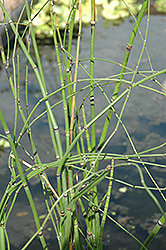Height: 4 feet
Spread: 4 feet
Sunlight:
![]()
![]()
Hardiness Zone: 2
Other Names: Equisetum japonicum, Scouring Rush
Description:
A perfect selection for a wet boggy area of the landscape or at the edge of a pond or stream; masses of towering bamboo-like spikes with black bands creates a bold vertical effect that makes an excellent backdrop for a water feature; very low maintenance
Ornamental Features
Barred Horsetail is primarily valued in the landscape or garden for its ornamental upright and spreading habit of growth. Its attractive spiny leaves remain green in colour with pointy black spines throughout the season.
Landscape Attributes
Barred Horsetail is a dense herbaceous perennial with an upright spreading habit of growth. Its medium texture blends into the garden, but can always be balanced by a couple of finer or coarser plants for an effective composition.
This is a relatively low maintenance plant, and is best cleaned up in early spring before it resumes active growth for the season. Deer don't particularly care for this plant and will usually leave it alone in favor of tastier treats. Gardeners should be aware of the following characteristic(s) that may warrant special consideration;
- Spreading
Barred Horsetail is ideally suited for growing in a pond, water garden or patio water container, and is recommended for the following landscape applications;
- Mass Planting
- Border Edging
- Water Gardens
- Bog Gardens
Planting & Growing
Barred Horsetail will grow to be about 4 feet tall at maturity, with a spread of 4 feet. It grows at a fast rate, and under ideal conditions can be expected to live for approximately 10 years. As an herbaceous perennial, this plant will usually die back to the crown each winter, and will regrow from the base each spring. Be careful not to disturb the crown in late winter when it may not be readily seen!
This plant does best in full sun to partial shade. As an aquatic plant, it requires a suitable water garden environment and will benefit from special planting and ongoing care practices; consult one of our in-store experts for further details and instructions. It is not particular as to soil type or pH. It is somewhat tolerant of urban pollution. This species is not originally from North America. It can be propagated by division.
